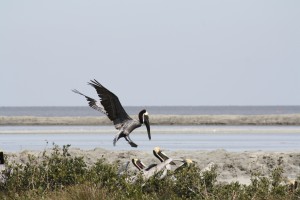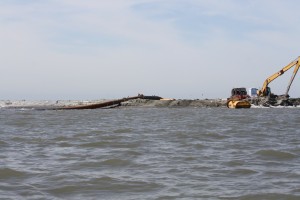When I started looking into coastal marsh and barrier island restoration, I had assumed that there would be a veritable ocean of information to wade through- what I hadn’t expected was the diverse nature of coastal issues depending on where you were. A lot of the information I came across focused on coastal areas in the Gulf of Mexico, which works very well for me, but I also found quite a bit for the New England coast as well, and it turns out that both the issues and the strategies are a bit site-specific.
The low-down. The statistics I found for the Louisiana coast were pretty horrifying- we are losing 62 km² of land per year (Lopez 2009) and the associated sea level rise along the Mississippi River deltaic plain is 10 mm per year (Boustany 2010). And that’s just the normal subsidence and erosion rate without catastrophic events- when Hurricanes Katrina and Rita came through in 2005, they removed a further 559 km² in just a few weeks. Why is this important? Well, the loss of barrier islands and coastal salt marshes means that our shores (and us) have effectively become more vulnerable- vulnerable to storms, vulnerable to rising sea levels (which means less land to work with), and vulnerable to changes in hydrology. As we lose marsh and water levels rise, saline environments are able to move ever-further inland- that might seem like a reasonable situation, especially since one of the big concerns is loss of nursery habitat for fish and shellfish in coastal areas- if everything moves inland, no harm, no foul, right? Except that remember people are living in these coastal areas- invading seawater creates problems with wells, less marsh to absorb high water events means more flooding of coastal settlements (a friend of mine ended up with serious brake issues in her car after regular extra-high tides flooded the driveway too many times), and some important species are best suited to brackish, rather than salt, water conditions.
In New England, the issues seemed to be more based around structural changes humans had made- we put in small culverts when constructing roads across tidal marshes, which restrict tidal flow sometimes leading to decreased salinity and increased algae (Konisky et al. 2006). We also created channels to facilitate boat traffic or blocked water movement to meet our needs. The resulting concerns here aren’t so much tied to storm protection or sinking driveways, but changes in nutrient cycling and natural processes that have made coastal areas more vulnerable to invasive species such as Phragmites reeds and less resilient to other changes.
How are coastal marshes and barrier islands restored? Often referred to as nourishment (because the idea is that you are providing these areas with the resources they need to survive the conditions they face), there are several different strategies for stopping barrier islands and salt marshes from disappearing. In terms of stopping a barrier island from slipping away in the face of wave and storm action, restoration projects can add sediment to dunes to make them more resilient, to the entire face of the beach from the top of the dunes to below the water line to give the entire beach more depth, and in the form of a ‘feeder bar’ offshore which would continuously feed the beach through wave and storm action (Campbell et al. 2005b). One area of concern has been how high to construct dunes on barrier islands- make them too high and the back of the island won’t be nourished, make them too low and they won’t absorb as much storm energy. You can also add sediment directly to salt marsh areas to counteract subsidence and even create new marsh areas through terrace/platform construction which can be planted with vegetation (Campbell et al. 2005a). Rozas et al. (2005) recommend that irregularly shaped islands be the goal with any of these strategies because crustaceans, such as shrimp and crabs, tend to congregate along marsh edges- the longer the shoreline, the more marsh edge there is.
Aside from nourishment, breakwaters and revetments can absorb and/or redirect wave action and erosion along the coast, and breaches and inlet closures can help recreate historical configurations of islands and marsh, if that is the goal (Campbell et al. 2005b)- although it’s important to remember that coastal change is a continuing process and there is no way to fully stop sediment loss (Landers 2007). To restore tidal flow, larger culverts can be installed and tidal channels can be excavated (Konisky et al. 2006).
Do these methods work? I think that’s the big question in many ways, especially since some of these projects are large-scale and expensive. We know that it is possible to add sediment to islands and marshes, but that doesn’t mean that you are restoring ecosystem function- these could be very compromised systems. Rozas et al. (2005) recommended marsh terracing as the most cost-effective method for restoring marshes and the crustacean fisheries associated with them, but that doesn’t mean that the end result is fully-functioning marsh. For next week I’ll see what I can dig up about success (or lack thereof) in coastal restoration projects- I’ll also try to find studies that expand beyond sediment and shrimp to get a better sense of what restoration means for other creatures.
Works cited:
Boustany, RG. 2010. Estimating the benefits of freshwater introduction into coastal wetland ecosystems in Louisiana: nutrient and sediment analysis. Ecological Restoration 28: 160-174.
Campbell, T., Benedet, L., and CW. Finkl. 2005a. Regional strategies for coastal restoration along Louisiana barrier islands. Journal of Coastal Research 44: 245-267.
Campbell, T., Benedet, L., and G. Thomson. 2005b. Design considerations for barrier island nourishments and coastal structures for coastal restoration in Louisiana. Journal of Coastal Research 44: 186-202.
Konisky, RA., Burdick, DM., Dionne, M., and HA. Neckles. 2006. A regional assessment of salt marsh restoration and monitoring in the Gulf of Maine. Restoration Ecology 14: 516-525.
Landers, J. 2007. Construction nears end on Louisiana coastal restoration project. Civil Engineering February: 22-23.
Lopez, JA. 2009. The multiple lines of defense strategy to sustain coastal Louisiana. Journal of Coastal Research 54: 186-197.
Rozas, LP., Caldwell, P., and TJ. Minello. 2005. The fishery value of salt marsh restoration projects. Journal of Coastal Research 40: 37-50.


